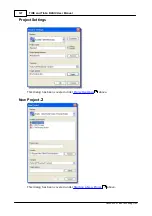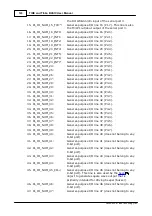
137
TIDE and Tibbo BASIC User Manual
©2000-2008 Tibbo Technology Inc.
and, hence, cannot be described in the object reference itself. Each platform
section in this manual has its own "Platform-dependent Programming Information"
topic. If you are reading documentation top-to-bottom (we have never actually
met anyone who does) you can skip this section now.
Supported variable types
This platform supports the following variable
: byte, word, char, short
(integer), string, boolean, user-defined structures and enumeration types. Dword,
long, and real (float) types are not supported.
There is no need to explicitly configure I/O lines as inputs or outputs
On this platform, each I/O line (controlled by the
object) can be an input and
an output at the same time (such lines are sometimes called "quasi-bidirectional").
This is why on this platform the io object does not have
property.
To sense the state of the external signal applied to the I/O line set the line to HIGH
first:
...
io.num= PL_IO_NUM
'just to select some line as an example
io.state= HIGH
'now we can read the line
x=io.state
'read line state into x
...
I/O lines are not "afraid" of "signal competition". That is, you won't damage the
line if it is outputting HIGH while external signal is driving it LOW, or vise versa. If
the line is driven LOW internally or externally, resulting state if the line is LOW.
For the hardware-savvy reader: output drivers of I/O lines on this
platform are implemented as open collector output with weak pull-up
resistor (~20K).
Remapping of I/O lines of the serial port is not possible
- TX/W1out/dout output, RX/W1in/din input,
RTS/W0out/cout output, and CTS/W0&1in/cin input have fixed positions and
cannot be reassigned to different I/O pins of the device. Therefore, on this platform
the
and
properties.
Explicit configuration of the I/O lines of the serial port as inputs or outputs
is not required
Since all I/O lines can serve as inputs and outputs at the same time it is not
necessary to explicitly configure
lines as inputs or outputs.
Serial port does not have a FIFO buffer
mode (
= PL_SER_MODE_UART,
= 1- ENABLED) the device is monitoring its CTS input to see if
attached serial device is ready to receive more data. If the CTS state changes to
"cannot transmit" the device will stop sending out data immediately. Outgoing
serial character that has already started transmitting will be sent out, but no more
43
365
370
224
224
249
249
224
224
226
255
255
253
















































